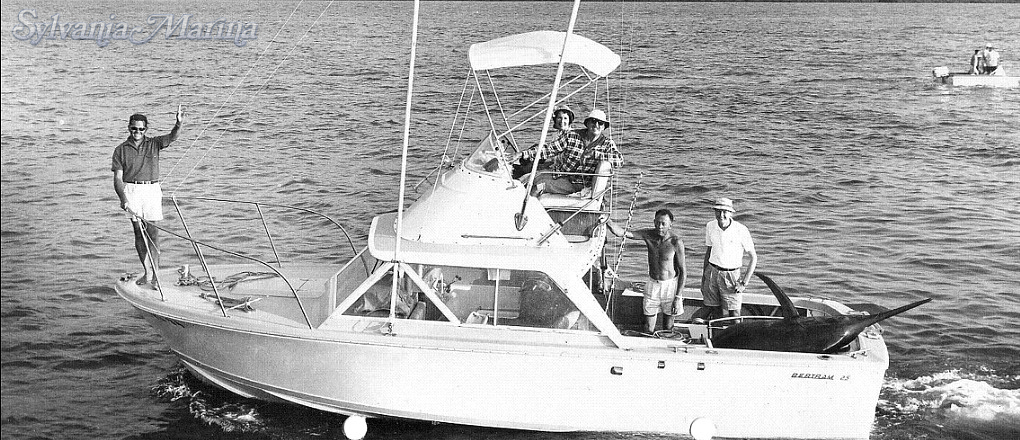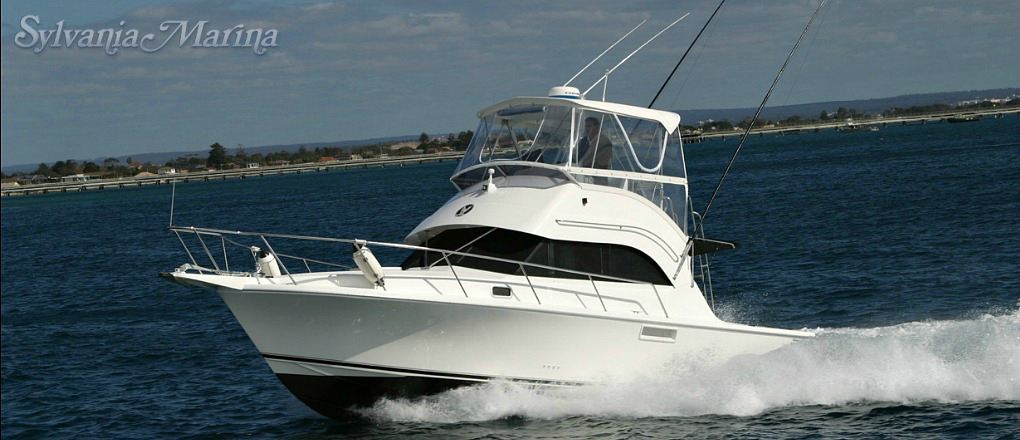2006 Caribbean 35 Boat Review

While the state of the Australian boat-building industry has fluctuated over the years and importers and brands have come and gone, Victorian manufacturer International Marine has quietly gone about its business and built in excess of 50,000 boats. That’s right, 50,000! An astounding number considering the consistent doom-and-gloom predictions from certain sections of the industry over the years.
The International Marine story began in 1958 when Arch Spooner built his first boat in the Melbourne suburb of Scorseby. In his first year, Arch and his six employees turned out 85 boats in the then-new technology of fibreglass construction.
In 1963, Arch was granted the rights to build the Bertram range of boats and to sell them both locally and overseas. International Marine manufactured the Bertram range right up until the closure of the Bertram Yacht Company in 1989.
International then bought the moulds and designs of the Bertram products and integrated them with their own ideas to come up with the Caribbean range of boats. That distinctive DNA provides us with the classic lines and sea-keeping ability that have given the Caribbean range its reputation as a good, solid all-rounder whether you’re competitively offshore fishing or socially cruising with the family.
One of their perennial stars has been the Caribbean 35 which as undergone some changes over the years, but still has retained a loyal following all over Australia.
TIMELESS CHARACTER
Caribbean has produced a pretty big boat for a 35-footer. The layout is twin-cabin with a single head and shower. The forward cabin has a large double berth which is offset to get it comfortably into the vee of the bow. There’s a hanging locker and vanity, and plenty of storage space under the bed. An opening hatch provides light and ventilation.
The guest cabin to port has two full-sized bunks, under-bunk stowage and drawers for your clothes. Opening ports provide the ventilation.
The bathroom to starboard has an electric macerator toilet with holding tank, a separate shower stall, 240V power and stowage lockers.
Moving aft to the galley and we find a very workable preparation area for cooking at rest or at sea. There’s an FRP moulded sink and counter tops with a modern mixer tap (upgraded since the last time I was on a 35). The front opening fridge is a 12/240V unit of 77-litre capacity. There’s a two-burner cooktop with fiddle rail and a convection microwave oven.
The main saloon is dominated by a comfortable four-seater dinette and a lounge to starboard which cleverly converts to a double bed with an overhead bunk – very handy for kids or unexpected guests. The entertainment package includes a flatscreen TV with DVD (upgraded to a larger model on the test boat), stereo unit with CD stacker, all your 12/240V circuit breakers as well as battery switches and the circuit breaker for the anchor winch.
Through the sliding door to the outdoors and we find the cockpit. And what a beauty it is. Arguably the biggest cockpit you’ll find on a 35-footer. Our test boat was fitted with an optional table for four and I reckon that even with chairs around it, you’d still have plenty of room fight a fish.
The cockpit has lockers in the coamings as well as a livebait tank on the transom. A substantial marlin door leads to the swim platform which isn’t too big to annoy anglers but big enough to use for boarding or swimming.
There’s also a hot/cold shower in the cockpit and a high-pressure saltwater deckwash.
In the forward starboard corner of the cockpit is an icebox that has been turned into a fridge/freezer on the test boat for those long cruises or weekends away.
UP ON TOP
Climbing up the ladder to the upper deck and the flybridge opens up to once again reveal plenty of space for lounging or entertaining. Two comfortable helm seats sit aft with a good view of the cockpit for berthing or fighting fish.
Electronics adorned the bridge console with a full compliment of Raymarine gear including E-Series plotter and auto pilot. The boat was also fitted with Cummins’ SmartCraft monitoring systems for the engines so you can see exactly what’s going on with them including accurate fuel-burn data and all engine systems.
Obviously, the engine controls were the latest electronic items from Cummins and featured automatic synchronisation of the engines so you only need to use one throttle control to get perfectly matched engine revs from both motors.
A Raymarine VHF, a chain counter and electronic fuel gauge were also close to hand. The 35 comes with a standard hardtop and our test boat was fitted with a full set of clears which Andrew Rose from St Kilda Boat Sales tells us are virtually a standard item but fitted locally.
There is seating for a further six adults up on the flybridge so it’s a convivial place to cruise or relax.
POWER UPGRADES
Although the lines and distinctive deep-vee hull shape of the Caribbeans has changed little, the interiors and appointments have been consistently upgraded to keep up with the times and the most recent, and indeed significant of these changes has been the change to fully-electronic Cummins engines.
Our test boat was fitted with a pair of Cummins QSB330 330hp turbo diesels which are in-line six-cylinder engines with a displacement of 5.9 litres.
These are quiet and clean-burning engines that are surprisingly responsive and in this age of spiralling fuel prices, quite economical. The Cummins’ are making peak torque at around 1800rpm and at that engine speed are producing around 285hp giving the 35 an economical cruise of 16kts using a frugal 26lt/h per engine.
At 2000rpm the engines are just off peak torque, but producing 309hp and a speed of around 20kts with a total burn of 63lt/h – very impressive.
Access to the engines is through a hatch in the main saloon and one of my few criticisms of this boat is that the engineroom is tight. The Cummins engines have been neatly fitted, but access around them is not what we would expect in a modern flybridge cruiser.
Getting the engines out would entail removing the saloon furniture and the floor, and then swimming them out the back door.
The Onan 7kVa generator is housed forward of the engines in a separate compartment and accessed from another hatch in the saloon floor.
ON THE WATER
One of the first things I noticed about the Caribbean is that it’s very manoeuvrable.
The marina at St Kilda is pretty tight, but we had no trouble decamping our berth using the engines alone without thrusters. Even though this boat feels big, it still behaves like a 35-footer in close quarters.
Out on the bay, it got up and out of the hole efficiently and didn’t bog down.
I found that a comfortable cruise speed of just under 20kts was perfect for the 35. As mentioned, this is achieved at around 2000rpm and at that the Cummins engines are spinning nicely with low noise levels and no fumes.
Turning off the wheel, the Caribbean leans nicely into the turns and doesn’t feel unstable. The steering is light and very responsive.
Top speed is around the 30kts mark at wide-open throttle of 2800rpm.
Moving around the boat under way isn’t a problem thanks to well-positioned handholds, but I did note that the sidedecks are not very wide and made even skinnier by the fitment of outriggers. That said there are stainless steel handrails leading up to the end of the cabin where the sturdy pulpit takes over. The foredeck is broad and there’s a Muir electric windlass mated to the aforementioned chain counter on the bridge.
Overall, I found little to complain about on the Caribbean 35. Certainly some will find the classic styling a bit dated but others will love it.
The internal styling is again not as modern as some of the new offerings on the market, but the use of space and the extra touches put in by the dealers at St Kilda give the boat a homey and somewhat customised effect.
With its inherent strength, sea-keeping ability and now with the new electronic Cummins engines, this is certainly a boat that’s worth a look.
HIGHS
- Good performance combined with cruising economy
- Solid reputation
- Roominess for a 35-footer including two-cabin layout
- Big cockpit
- Verstility
LOWS
- Cramped engine room
- Narrow side decks
- No extractor fan in bathroom
- Fit and finish not quite up with Euro boats
| CARIBBEAN 35 FLYBRIDGE |
| HOW MUCH? |
| Price as tested: $519,471 |
| Options fitted: Fridge/Freezer in cockpit, cockpit table, live bait tank, 32-inch TV in Saloon, TV in Forward cabin, Intercom, electric BBQ, rod holders, flybridge clears, Raymarine electronics, Reelax game poles, ice maker and more |
| Priced from: $430,000 |
| GENERAL |
| Material: Hand laid fibreglass |
| Type: Monohull |
| Length overall: 10.35m plus swim platform |
| Beam: 4.03m |
| Draft: .09m |
| Height: 3.5m |
| Weight: 8500kg |
| CAPACITIES |
| Berths: 4 + 3 |
| Fuel: 1350 litres |
| Water: 405 litres |
| ENGINE |
| Make/Model: Cummins Electronic QSB330 |
| Type: Fully electronic six-cylinder diesel with turbocharging and aftercooling |
| Rated HP: 330 @ 2800rpm |
| Displacement: 5.9 litre |
| Weight: 612kg |
| Props: Four-blade aluminium/bronze |
**Review written 2006







Connect With Us